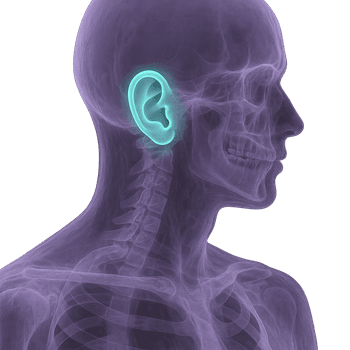Quick version
The ear is an important organ for both hearing and balance.
- Consists of the outer ear, middle ear, and inner ear
- Collects and converts sound into nerve signals
- The organ of balance is located in the inner ear
- Common symptoms include tinnitus and hearing loss
- Can be affected by infections and pressure changes
What is the ear?
The ear is the sensory organ that records sound waves and converts them into nerve signals that the brain can interpret as sound. It also plays an important role in the body's ability to balance. The ear is divided into the outer ear, middle ear, and inner ear, with each part having a specific function in sound processing.
The outer ear
The outer ear consists of the pinna (auricle) and ear canal. The pinna and ear canal collect sound waves and direct them inward toward the eardrum. The shape of the outer ear helps to localize the direction of sound.
The middle ear
The middle ear contains three small bones—the hammer, the anvil, and the stirrup—that amplify sound waves and transmit them to the inner ear. The eustachian tube is also located here, which helps equalize the pressure between the middle ear and the environment.
Inner ear
The inner ear contains the cochlea, where sound waves are converted into nerve signals. The semicircular canals, which are part of the balance organ and register the movements of the head, are also located here.
The function of hearing
Sound waves reach the eardrum and set it in vibration. These vibrations are transmitted via the auditory ossicles to the inner ear, where hair cells in the cochlea send electrical signals to the auditory nerve and on to the brain.
The role of balance
The semicircular canals and otolith organs in the inner ear help the body sense the position and movement of the head. This information is sent to the brain and coordinated with vision and touch to maintain balance.
Common Conditions and Diseases of the Ear
There are a variety of conditions that can affect the ear, ranging from infections to injuries and neurological problems. Here are some common diseases:
- Acute otitis media: A bacterial middle ear infection, common in children. Causes pain, fever and sometimes hearing loss.
- Otitis externa (inflammation of the ear canal): Often caused by moisture and bacteria, common among swimmers. Causes itching, pain and swelling.
- Tinnitus: A persistent sound in the ears without an external sound source. May be due to hearing damage, stress or other illnesses.
- Menière's disease: Causes recurrent attacks of dizziness, tinnitus and fluctuating hearing loss.
- Barotrauma: Injury caused by pressure changes, e.g. when flying or diving. Can cause pain and temporary hearing loss.
- Hearing loss: Can be temporary or permanent and has many causes – from earwax to nerve damage.
Examination and diagnosis of ear problems
Different methods are used to diagnose ear-related problems, depending on the symptoms:
- Otoscopy: A doctor looks into the ear with an otoscope to assess the eardrum and ear canal.
- Pure tone audiometry: A hearing test where you listen to tones at different frequencies and volumes.
- Tympanometry: Measures the mobility of the eardrum to detect fluid in the middle ear or pressure changes.
- Balance examination: In cases of dizziness, tests such as caloric stimulation or video nystagmography.
- Samples: In case of infections, blood samples or samples from the ear can be analyzed.
Relevant symptoms
- Hearing loss
- Tinnitus (ringing in the ears)
- Pain in the ear
- Dizziness or balance problems
- Fluid from the ear
Related conditions and diagnoses
- Ear inflammation (otitis)
- Tinnitus
- Menière's disease
- Ear canal eczema
- Hearing loss
- Barotrauma
























